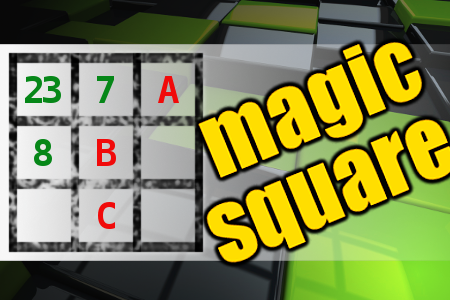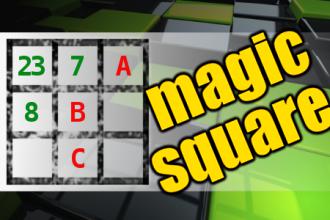MAGIC SQUARE: Calculate A+B-C
The aim is to place the some numbers from the list (5, 7, 8, 22, 23, 25, 26, 29, 30, 32, 33, 34, 40) into the empty squares and squares marked with A, B an C. Sum of each row and column should be equal. All the numbers of the magic square must be different. Find values for A, B, and C. Solution is A+B-C.
37 Christmas jokes
Why is the Grinch such a good gardener?
He has a green thumb.
What type of key do you need to put on a Nativity play?
A don-key.
Who is the only one to not eat at Christmas dinner?
The turkey, it’s always stuffed!
Why was the advent calendar afraid?
Its days were numbered!
What’s the best present to receive?
A broken drum, you just can’t beat it.
What’s a dog’s favorite Christmas song?
Bark, the Herald Angels Sing.
What carol is heard in the desert?
O camel ye faithful.
How can you tell that Santa is real?
You can always sense his presents.
What do you call a bankrupt Santa?
Saint Nick-less.
Who is Santa’s favorite singer?
Beyon-sleigh.
What does Santa clean his sleigh with?
Santa-tizer.
What kind of motorcycle does Santa ride?
A Holly Davidson.
How much did Santa pay for his sleigh?
Nothing, it was on the house.
Why did Santa’s helper start going to therapy?
He had low “elf” esteem.
What do Santa’s helpers learn in school?
The elf-abet.
What would you find on an elf’s Instagram account?
Lots of elf-ies.
Who is the best singer in the North Pole?
Elf-is Presley.
What did the elf on the shelf dress up as for Halloween?
Prankenstein.
Why didn’t Rudolph make honor roll in school this term?
Because he went down in history.
Which reindeer does Santa always have to discipline?
Rude-olph.
What do reindeer say before they tell a joke?
This one will sleigh you!
What do you get if you cross a snowman and a vampire?
Frostbite.
How did the snowman get to work?
By icicle!
What do snowmen wear on their heads?
Ice caps.
What do snowmen call their offspring?
Chill-dren.
What do grapes sing at Christmas?
‘Tis the season to be jelly.
Why shouldn’t you prank the eggnog?
It can’t take a yolk.
What did the gingerbread man put on his bed?
A cookie sheet.
Why don’t penguins fly?
They’re not tall enough to be pilots!
What do you call an art museum made out of ice?
The Ig-Louvre.
What’s as big as a Christmas tree but is lighter than a feather?
Its shadow.

